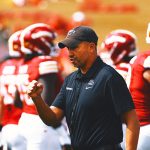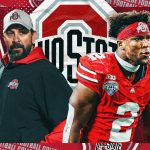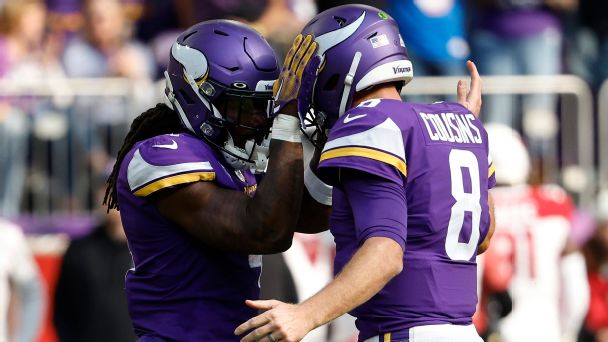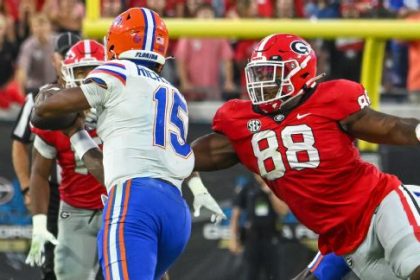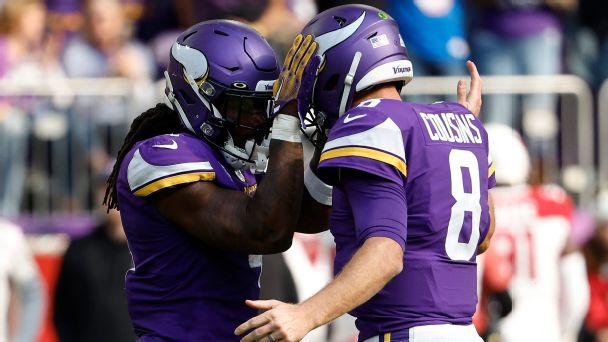
Minnesota Vikings general manager Kwesi Adofo-Mensah offered a high-level preview of decisions he faces over the next two weeks during a 15-minute session with national reporters Tuesday at the NFL combine. It was a lot.
Adofo-Mensah brings a genial personality to such settings, regularly dropping pop culture references to lighten the mood. (Tuesday’s was a “Seinfeld” allusion comparing reporters to the fictional “hack” comedian Kenny Bania.) The subject matter in Indianapolis, however, was intense.
Adofo-Mensah noted the volume of decisions he needs to make and, on multiple occasions, spoke about the consequence if things go wrong.
“The job is to build a championship team within the time window,” he said. “So yeah, if I get fired in four years and all my picks hit after that, I don’t get to go back and say, ‘Hey, look at all those people I drafted.’ It’s my job to put it all together within the same timeframe, same horizon. So it’s really just, a lot of different lessons that I’ve learned from various studies I’ve done to kind of put it together, but there isn’t just one right way. It’s just a lot of smart, intentional decisions that you make.”
Between now and March 15, when the NFL’s new league year begins, Adofo-Mensah must find a way to trim at least $24 million in salary cap space, leaving room for a potential record-breaking contract extension for receiver Justin Jefferson. He’ll decide the long-term future of quarterback Kirk Cousins, based on whether the sides agree to a contract extension, and could bid farewell to a third of 2022 team’s starting lineup.
Let’s pull together a few months of reporting on how the Vikings will proceed with players on their roster for the 2023 season, from Cousins’ future to the long-term possibilities for running back Dalvin Cook, receiver Adam Thielen and a host of defensive starters, and attempt to project the Adofo-Mensah’s plans.

WR Adam Thielen
Why it’s a question: Thielen has a big cap number ($19.97 million) following a 2022 restructure and would receive $13.5 million in cash. Those figures would make sense for a youngish 1,000-yard receiver, as Thielen was during the height of his career. While he was exceptionally durable in 2022, starting all 17 games and running the second-most routes in the NFL, he will turn 33 in August and his on-field numbers suggest a slow down. His average of 2.27 yards after the catch ranked No. 128 out of 130 qualified pass-catchers in 2022, pointing to a lack of separation from opponents.
Financial impact: The Vikings would save $6.4 million by releasing him or, if he was willing, could save about the same by reducing his $11.8 million base salary.
Reading the tea leaves: Thielen told ESPN last month he wants to retire a Viking, but “I also want my opportunity to show that I can play at a high level.” Over the final five games last season, he ranked fourth on the Vikings in receptions behind Jefferson, T.J. Hockenson and K.J. Osborn. In a thin free agent market for receivers, Thielen might not be willing to take a big pay cut and secondary role, making a release the likeliest outcome.

RB Dalvin Cook
Why it’s a question: He’ll turn 28 in August, a past-prime age at his position. In 2022, for example, three NFL running backs 28 or older rushed for more than 500 yards. He is due $11 million in cash, the third-most for a 2023 running back, and is set to count $14.1 million against the cap. On the other hand, he started every game last season for the first time in his career and had a chronic shoulder injury repaired in the offseason.
Financial impact: The shoulder surgery makes this a bit tricky. Of his 2023 base salary, $2 million is guaranteed for injury. If they release him and he can’t pass a physical, they would owe him the $2 million but save $5.9 million in cap space. If he passes a physical, releasing him would save $7.9 million in cap space.
Reading the tea leaves: A release was the likeliest outcome before the shoulder surgery. Now, it’s a matter of whether the Vikings would be willing to eat the $2 million to get cap relief. Coach Kevin O’Connell loves Cook’s skill set, especially in the passing game, and gave him more snaps than he had seen in his career. And the Vikings have no obvious replacement on the roster, with the pending expiration of backup Alexander Mattison‘s contract. But everything about Adofo-Mensah’s approach suggests he would prefer not to pay and rely on an aging running back, and instead turn to the draft or free agency for a replacement. Speaking Tuesday, Adofo-Mensah said Cook is a “great player and great leader” but added: “In the NFL, you have a lot of constraints, salary cap different things, and we’re trying to figure out how we can operate in those things.”

QB Kirk Cousins
Why it’s a question: There really isn’t doubt about where Cousins will play in 2023; Adofo-Mensah has said he expects Cousins to be the Vikings’ starter. What isn’t obvious is how the team will proceed to that point. Cousins’ contract has one year remaining, calling for him to receive $30 million in cash and count $36.3 million against the cap. The Vikings could reduce that cap number with a contract extension, but Cousins would have the leverage to ask for guaranteed money that would in essence lock him in as a starter into the 2024 season and potentially beyond. He turns 35 in August.
Financial impact: Depending on the length of an extension, the Vikings could shave at least $10 million off Cousins’ 2023 cap figure.
Reading the tea leaves: Appearing Tuesday on the NFL Network, which has reported a one-year extension is unlikely, Adofo-Mensah spoke in neutral terms: “We’re just trying to find great solutions,” he said. The Vikings might not want to do anything beyond a one-year deal, but they’re hamstrung by the complete lack of a succession plan. Cousins has missed one start in his career for health reasons, and there’s a growing body of evidence for quarterbacks playing at a high level into their late 30s. But if there isn’t going to be a one-year deal, the likeliest scenario is Cousins entering the season in the final year of his current contract.

Why it’s a question: Smith’s contract has no more guaranteed money remaining, which allows the Vikings to move on with minimal cap damage if they want. Smith made a huge impact in the beginning of the 2022 season, recording 8.5 sacks through Week 7, but a chronic knee injury slowed him down and he managed 1.5 sacks the rest of the way. He’ll turn 31 in September and if the Vikings want to keep him, he is currently on the books for $15.5 million in cash.
Financial impact: Releasing Smith would save $12.2 million against the salary cap.
Reading the tea leaves: New defensive coordinator Brian Flores plans to use a 3-4 scheme that would seem to fit Smith’s skills and past success. But a cold calculation of Smith’s age and his performance in the second half of last season would send red flags about remaining committed to him at his current numbers. Smith isn’t likely to feel compelled to take a pay cut, if the Vikings offer it, given the way pass-rushers are typically valued on the free agent market. Releasing Smith would be a clear path to opening up salary cap space.

Why it’s a question: Hunter’s contract has one year remaining at a relatively small base salary of $4.9 million, plus up to $600,000 in roster and workout bonuses. That would represent about one-fourth of what he earned in 2022, when he returned from two years of injuries to start 17 games and record 10.5 sacks. But his salary cap number for 2023 is $13.1 million, and despite the 2022 sack total, he did not always look comfortable as a standup outside linebacker in the 3-4 scheme.
Financial impact: Releasing or trading Hunter would accelerate an additional $5.7 million onto the Vikings’ salary cap. A new deal could shave $10 million from his 2023 cap figure.
Reading the tea leaves: Hunter is 28 and proved last season he was past his injury battles of 2020 and 2021. Given the value of pass rushing, and the potential of Smith’s departure, a contract extension would be the smartest approach to take with Hunter. If the sides can’t agree, however, the possibility of a trade shouldn’t be ruled out. Hunter is the Vikings’ most lucrative (and realistic) asset if they want to replenish their supply of 2023 draft picks (the Vikings currently have four picks.)


What it’s a question: The Vikings’ 2022 starting inside linebackers are in an interconnected spot. Both will be 31 this season, are entering the final years of their contracts and have no guaranteed money due to them in 2023. And the Vikings seem keen on getting 2022 third-round draft pick Brian Asamoah into a prominent role in 2023. They both stayed healthy enough to start all 17 games last season but at times struggled with the coverage responsibilities they were asked to carry out in former defensive coordinator Ed Donatell’s scheme.
Financial impact: The Vikings can save $9.5 million against the cap by moving on from Kendricks and $5 million if they release Hicks.
Reading the tea leaves: One or both of these veterans will not be on the roster in September. Asamoah is expected to take one starting job, and it’s worth noting that Adofo-Mensah went out of his way to mention 2022 backups Troy Dye and William Kwenkeu Tuesday at the combine.

Why it’s a question: Smith just turned 34, missed a total of three games last season because of two different injuries and has no guaranteed money left on his contract. It seems reasonable that Flores would do a better job of using Smith’s strengths, which include blitzing and getting into the backfield on running plays, but it’s hard to imagine Adofo-Mensah valuing that possibility enough to justify a current contract that calls for Smith to earn $18.1 million in cash and count $22.1 million against the cap — especially with 2022 first-round pick Lewis Cine expected to make a full recovery from a season-ending leg injury.
Financial impact: Releasing Smith would save $18.1 million against the cap, while a restructured contract could shave more than half of their total cap commitment to him.
Reading the tea leaves: The outcome here is likely to depend on Smith’s appetite for playing a 12th NFL season, and if so, whether he will take a significant pay cut to do it. If so, the Vikings could see some value in his veteran presence and on-the-line playmaking skills. If not, he could be another player who is released.

